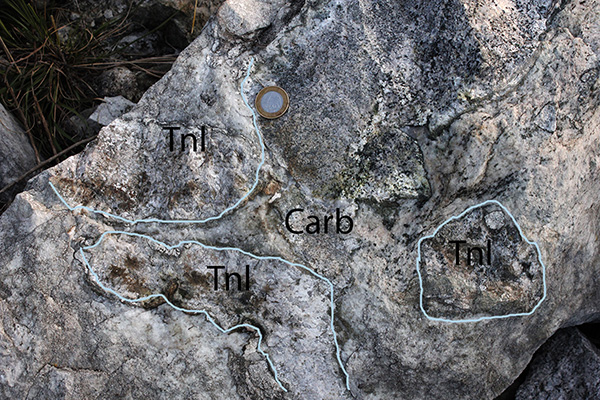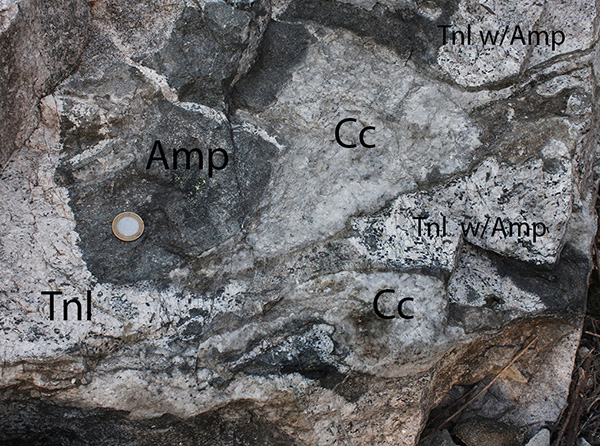Syenite-diorite intrusion into marble, Matarazzo-Brasileiro quarry, Dom Feliciano Belt, Rio Grande do Sul, Brazil
|
| This page describes syenite and diorite dyke intrusions into marble. The marble is calcite rich but has diopside, wollastonite and anorthite, as well as isolated quartz grains or quartz grains associated with wollastonite. Mafic dykes have evidence of partial melting forming leucosomes with large peritectic augite in a syenitic matrix. Augite syenite forms their own dykes carrying blocks of source diorite. Both mafic and syenitic dykes interact with marble forming highly irregular margins, mingling features and different kinds of skarn. Early dykes, now amphibolites, several metres wide have been broken up into isolated blocks in the marble with an alteration margin. Most dykes, felsic and mafic intruded into hot marble and their contacts are highly irregular, and marble dykes also intrude and disaggregate the dykes, giving rise to structures similar to back-veining. Blobs of syenite and diorite can also be found inside the marble forming a structure similar to pillows resulting from magma mingling, except for highly irregular, rather than smooth rounded margins. Mafic dykes have different kinds of skarn at the contact with the marble: titanite concentrations, or anorthosites comprising mostly anorthite with diopside rimmed by Ca-amphiboles. Late thin dykes have straight margins and can be boudinaged surrounded by an alteration band of orange grossular, or be planar and lack any evidence of reaction with the marble. Our interpretation is that during peak metamorphism, amphibolite and early diorite dykes underwent partial melting. The resulting augite syenite intruded the marble carrying blocks of the mafic source. In the process of intrusion it interacted with a partially molten marble and reacted with it. Durand et al (2015) have shown that in the presence of water, carbonates melt at temperatures around 650 C. We interpret the structures as resulting from the interaction between the intrusive silicate melts and a partially molten, water-fluxed marble. The syenite is metasomatically altered close to the marble and is rich in up to 1cm long titanite develops, as well as large poikilitic K-feldspar. |
Intrusion of irregular dykes into marble |
Amphibolite melt to produce tonalite
Intrusions of syenite into marble: irregular shapes.
Feathery contacts between syenite and marble.
Irregular intrusion with feathery contacts. |
Irregular intrusion with feathery contacts. |
Feathery contacts. |
Alteration of syenite close to marble contact.
Angular amphibolite blocks in marble.
Clean marble clouds in marble surrounding intrusions.

